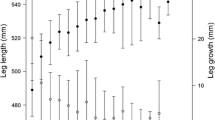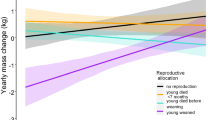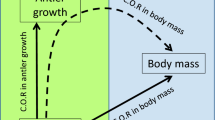Abstract
Reproduction can lead to a trade-off with growth, particularly when individuals reproduce before completing body growth. Kangaroos have indeterminate growth and may always face this trade-off. We combined an experimental manipulation of reproductive effort and multi-year monitoring of a large sample size of marked individuals in two populations of eastern grey kangaroos to test the predictions (1) that reproduction decreases skeletal growth and mass gain and (2) that mass loss leads to reproductive failure. We also tested if sex-allocation strategies influenced these trade-offs. Experimental reproductive suppression revealed negative effects of reproduction on mass gain and leg growth from 1 year to the next. Unmanipulated females, however, showed a positive correlation between number of days lactating and leg growth over periods of 2 years and longer, suggesting that over the long term, reproductive costs were masked by individual heterogeneity in resource acquisition. Mass gain was necessary for reproductive success the subsequent year. Although mothers of daughters generally lost more mass than females nursing sons, mothers in poor condition experienced greater mass gain and arm growth if they had daughters than if they had sons. The strong links between individual mass changes and reproduction suggest that reproductive tactics are strongly resource-dependent.

Similar content being viewed by others
References
Allal N, Sear R, Prentice AM, Mace R (2004) An evolutionary model of stature, age at first birth and reproductive success in Gambian women. Proc R Soc Lond B Biol Sci 271:465–470. doi:10.2307/4142682
Bårdsen BJ, Fauchald P, Tveraa T, Langeland K, Yoccoz NG, Ims RA (2008) Experimental evidence of a risk-sensitive reproductive allocation in a long-lived mammal. Ecology 89:829–837
Beauplet G, Guinet C (2007) Phenotypic determinants of individual fitness in female fur seals: larger is better. Proc R Soc Lond B Biol Sci 274:1877–1883
Beauplet G, Barbraud C, Dabin W, Küssener C, Guinet C (2006) Age-specific survival and reproductive performances in fur seals: evidence of senescence and individual quality. Oikos 112:430–441
Bérubé CH, Festa-Bianchet M, Jorgenson JT (1996) Reproductive costs of sons and daughters in Rocky Mountain bighorn sheep. Behav Ecol 7:60–68
Birgersson B (1998) Adaptive adjustment of the sex ratio: more data and considerations from a fallow deer population. Behav Ecol 9:404–408
Cameron EZ, Lemons PR, Bateman PW, Bennett NC (2008) Experimental alteration of litter sex ratios in a mammal. Proc R Soc Lond B Biol Sci 275:323–327
Clutton-Brock T, Huchard E (2013) Social competition and its consequences in female mammals. J Zool 289:151–171. doi:10.1111/jzo.12023
Clutton-Brock T, Sheldon BC (2010) Individuals and populations: the role of long-term, individual-based studies of animals in ecology and evolutionary biology. Trends Ecol Evol 25:562–573. doi:10.1016/j.tree.2010.08.002
Clutton-Brock TH, Albon SD, Guinness FE (1981) Parental investment in male and female offspring in polygynous mammals. Nature 289:487–489
Clutton-Brock TH, Guinness FE, Albon SD (1983) The costs of reproduction to red deer hinds. J Anim Ecol 52:367–383
Crawley MJ (2007) The R book. Wiley, Chichester
Cripps JK, Wilson ME, Elgar MA, Coulson G (2011) Experimental manipulation of fertility reveals potential lactation costs in a free-ranging marsupial. Biol Lett 7:859–862
Davis N, Forsyth D, Coulson G (2010) Facilitative interactions between an exotic mammal and native and exotic plants: hog deer (Axis porcinus) as seed dispersers in south-eastern Australia. Biol Invasions 12:1079–1092
Festa-Bianchet M (1989) Individual differences, parasites, and the costs of reproduction for bighorn ewes (Ovis canadensis). J Anim Ecol 58:785–795
Festa-Bianchet M, Gaillard J-M, Jorgenson JT (1998) Mass and density-dependent reproductive success and reproductive costs in a capital breeder. Am Nat 152:367–379
Gaillard J-M, Sempéré AJ, Boutin J-M, Laere GV, Boisaubert B (1992) Effects of age and body weight on the proportion of females breeding in a population of roe deer (Capreolus capreolus). Can J Zool 70:1541–1545
Gallant BY, Réale D, Festa-Bianchet M (2001) Does mass change of primiparous bighorn ewes reflect reproductive effort? Can J Zool 79:312–318
Gélin U, Wilson ME, Coulson GM, Festa-Bianchet M (2013) Offspring sex, current and previous reproduction affect feeding behaviour in wild eastern grey kangaroos. Anim Behav 86:885–891. doi:10.1016/j.anbehav.2013.08.016
Gerhart KL, Russell DE, DeWetering DV, White RG, Cameron RD (1997) Pregnancy of adult caribou (Rangifer tarandus): evidence for lactational infertility. J Zool 242:17–30
Gittleman JL, Thompson SD (1988) Energy allocation in mammalian reproduction. Am Zool 28:863–875
Glazier DS (1999) Trade-offs between reproductive and somatic (storage) investments in animals: a comparative test of the Van Noordwijk and De Jong model. Evol Ecol 13:539–555
Green B, Newgrain K, Merchant J (1980) Changes in milk composition during lactation in the tammar wallaby (Macropus eugenii). Aust J Biol Sci 33:35–42
Green WCH, Rothstein A (1991) Trade-offs between growth and reproduction in female bison. Oecologia 86:521–527
Gustafsson L, Sutherland W (1988) The costs of reproduction in the collared flycatcher Ficedula albicollis. Nature 335:813–815
Hamel S, Côté SD (2009) Foraging decisions in a capital breeder: trade-offs between mass gain and lactation. Oecologia 161:421–432
Hamel S, Côté SD, Festa-Bianchet M (2010a) Maternal characteristics and environment affect the costs of reproduction in female mountain goats. Ecology 91:2034–2043. doi:10.1890/09-1311.1
Hamel S, Gaillard J-M, Yoccoz NG, Loison A, Bonenfant C, Descamps S (2010b) Fitness costs of reproduction depend on life speed: empirical evidence from mammalian populations. Ecol Lett 13:915–935. doi:10.1111/j.1461-0248.2010.01478.x
Hector KL, Nakagawa S (2012) Quantitative analysis of compensatory and catch-up growth in diverse taxa. J Anim Ecol 81:583–593. doi:10.1111/j.1365-2656.2011.01942.x
Helle S (2008) A trade-off between reproduction and growth in contemporary Finnish women. Evol Hum Behav 29:189–195. doi:10.1016/j.evolhumbehav.2007.11.009
Inwood D, Catanchin H, Coulson G (2008) Roo town slow down: a community-based kangaroo management plan for Anglesea. In: Lunney D, Munn A, Meikle W (eds) Too close for comfort: contentious issues in human-wildlife encounters. Royal Zoological Society of New South Wales, Sydney, pp 1–8
Jaremovic R, Croft D (1991) Social organization of eastern grey kangaroos in southeastern New South Wales. II. Associations within mixed groups. Mammalia 55:543–554
Jarman P (1983) Mating system and sexual dimorphism in large, terrestrial, mammalian herbivores. Biol Rev 58:485–520. doi:10.1111/j.1469-185X.1983.tb00398.x
King WJ, Wilson ME, Allen T, Festa-Bianchet M, Coulson G (2011) A capture technique for free-ranging eastern grey kangaroos (Macropus giganteus) habituated to humans. Aust Mammal 33:47–51
Koivula M, Koskela E, Mappes T, Oksanen TA (2003) Cost of reproduction in the wild: manipulation of reproductive effort in the bank vole. Ecology 84:398–405. doi:10.1890/0012-9658(2003)084[0398:CORITW]2.0.CO;2
Le Gall-Payne C, Coulson G, Festa-Bianchet M (2015) Supersize me: heavy eastern grey kangaroo mothers have more sons. Behav Ecol Sociobiol 69:795–804. doi:10.1007/s00265-015-1896-y
Maguire G, Ramp D, Coulson G (2006) Foraging behaviour and dispersion of eastern grey kangaroos (Macropus giganteus) in an ideal free framework. J Zool 268:261–269
Martin JGA, Festa-Bianchet M (2010) Sex ratio bias and reproductive strategies: What sex to produce when? Ecology 92:441–449. doi:10.1890/09-2413.1
Martin JGA, Festa-Bianchet M (2011) Age-independent and age-dependent decreases in reproduction of females. Ecol Lett 14:576–581. doi:10.1111/j.1461-0248.2011.01621.x
Martin JGA, Pelletier F (2011) Measuring growth patterns in the field: effects of sampling regime and methods on standardized estimates. Can J Zool 89:529–537. doi:10.1139/z11-018
McNamara JM, Houston AI (1996) State-dependent life histories. Nature 380:215–221
Nilsen E, Brøseth H, Odden J, Linnell J (2010) The cost of maturing early in a solitary carnivore. Oecologia 164:943–948
Peig J, Green AJ (2009) New perspectives for estimating body condition from mass/length data: the scaled mass index as an alternative method. Oikos 118:1883–1891. doi:10.1111/j.1600-0706.2009.17643.x
Persson J (2005) Female wolverine (Gulo gulo) reproduction: reproductive costs and winter food availability. Can J Zool 83:1453–1459
Poole WE (1975) Reproduction in the two species of grey kangaroos, Macropus giganteus Shaw and M. fuliginosus (Desmarest). II. Gestation, parturition and pouch life. Aust J Zool 23:333–353
Poole WE, Carpenter SM, Wood JT (1982) Growth of grey kangaroos and the reliability of age determination from body measurements. I. The eastern grey kangaroo, Macropus giganteus. Aust Wildl Res 9:9–20
Reznick D (1985) Costs of reproduction: an evaluation of the empirical evidence. Oikos 44:257–267
Rickard IJ, Russell AF, Lummaa V (2007) Producing sons reduces lifetime reproductive success of subsequent offspring in pre-industrial Finns. Proc R Soc Lond B Biol Sci 274:2981–2988
Robert KA, Schwanz LE, Mills HR (2010) Offspring sex varies with maternal investment ability: empirical demonstration based on cross-fostering. Biol Lett 6:242–245. doi:10.1098/rsbl.2009.0774
Roff DA (2002) Life history evolution. Sinauer Associates, Sunderland
Sinervo B, DeNardo DF (1996) Costs of reproduction in the wild: path analysis of natural selection and experimental tests of causation. Evolution 50:1299–1313
Stearns SC (1992) The evolution of life histories. Oxford University Press, Oxford
Steele BM, Hogg JT (2003) Measuring individual quality in conservation and behavior. Animal behavior and wildlife conservation. Island Press, Washington, pp 243–270
Stewart KM, Bowyer RT, Dick BL, Johnson BK, Kie JG (2005) Density-dependent effects on physical condition and reproduction in North American elk: an experimental test. Oecologia 143:85–93
Tavecchia G, Coulson TN, Morgan BJT, Pemberton JM, Pilkington J, Gulland FMD, Clutton-Brock TH (2005) Predictors of reproductive cost in female Soay sheep. J Anim Ecol 74:201–213
Trivers RL, Willard DE (1973) Natural selection of parental ability to vary the sex ratio of offspring. Science 179:90–92
van Noordwijk AJ, de Jong G (1986) Acquisition and allocation of resources: their influence on variation in life history tactics. Am Nat 128:137–142. doi:10.2307/2461293
Weckerly FW (1998) Sexual-size dimorphism: influence of mass and mating systems in the most dimorphic mammals. J Mammal 79:33–52
Weladji RB, Loison A, Gaillard JM, Holand O, Mysterud A, Yoccoz NG, Nieminen M, Stenseth NC (2008) Heterogeneity in individual quality overrides costs of reproduction in female reindeer. Oecologia 156:237–247
Wilson ME (2012) Fertility control for managing eastern grey kangaroos (Macropus giganteus). Ph.D. dissertation. School of BioSciences, The University of Melbourne, Melbourne
Wilson ME, Coulson G, Shaw G, Renfree MB (2013) Deslorelin implants in free-ranging female eastern grey kangaroos (Macropus giganteus): mechanism of action and contraceptive efficacy. Wildl Res 40:403–412
Zuur AF, Ieno EN, Walker NJ, Saveliev AA, Smith G (2009) Mixed effects models and extensions in ecology with R. Springer SBM, New York
Acknowledgments
We thank all students and volunteers who assisted with kangaroo captures, and Sébastien Rioux-Paquette for statistical advice. The Natural Sciences and Engineering Research Council of Canada, Parks Victoria, the Australian Research Council Linkage Project (LP0560344) and the Holsworth Wildlife Research Endowment provided financial support. We thank Parks Victoria and the Anglesea Golf Club for logistic support. Research Endowment Animal handling and experimental procedures were approved by the Animal Care Committee of the Université de Sherbrooke (protocol MFB-2012-2) and by the Faculty of Science Animal Ethics Committee of the University of Melbourne (Projects 486-004-0-92-1157, 654-125-0-94-1617 and 06146).
Author contribution statement
UG and MFB conceived, designed, and executed this study. UG analyzed the data and wrote the manuscript. MFB read and provided advice on an earlier version of the manuscript. UG, MFB, JC, MW, GC conducted fieldwork and provided advice on the last version of the manuscript.
Author information
Authors and Affiliations
Corresponding author
Additional information
Communicated by Hannu J. Ylonen.
Rights and permissions
About this article
Cite this article
Gélin, U., Wilson, M.E., Cripps, J. et al. Individual heterogeneity and offspring sex affect the growth–reproduction trade-off in a mammal with indeterminate growth. Oecologia 180, 1127–1135 (2016). https://doi.org/10.1007/s00442-015-3531-z
Received:
Accepted:
Published:
Issue Date:
DOI: https://doi.org/10.1007/s00442-015-3531-z




